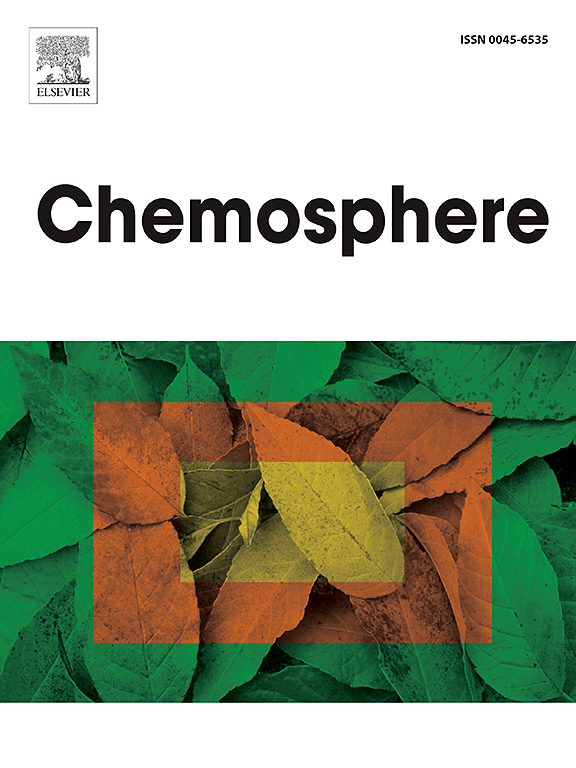电fenton法去除磺胺多辛:反应动力学、氧化途径及电极稳定性
IF 8.1
2区 环境科学与生态学
Q1 ENVIRONMENTAL SCIENCES
引用次数: 0
摘要
在这项研究中,首次研究了电fenton (EF)工艺在市售压滤电化学电池中去除磺胺多辛(SDX)。采用气体扩散电极(GDE)作为阴极,尺寸稳定阳极(DSA)作为阳极。考察了电流密度、再循环流量和pH对H2O2生成的影响。在50 mA/cm2、200 mL/min、pH 7条件下,H2O2浓度达到457 mg/L。在相同条件下,研究了Fe2+对SDX氧化矿化的影响。对于0.5 mM Fe2+, SDX在10分钟内被去除,2小时后总有机碳(TOC)去除率达到77.4%。值得注意的是,在接近中性的pH下观察到铁沉淀,这表明通过混凝和吸附去除SDX可能除了氧化外还有助于SDX的去除。通过LC/HRMS Orbitrap鉴定了5个转化产物(TPs),其中4个是新报道的。使用ECOSAR软件评估了TPs对鱼类、水蚤和绿藻的急性和慢性毒性。大多数TPs的毒性低于SDX,但有些毒性增加,这表明可能需要更长时间或更强的治疗。用0.1 mM Fe2+连续10次循环评价GDE的稳定性。SDX去除率保持稳定,在72.2% ~ 85.4%之间,而H2O2发电量在最终循环时从481.4 mg/L稳定下降到200.6 mg/L。这些结果表明,虽然EF可以有效去除SDX,但长期使用需要改善H2O2生成的稳定性。本文章由计算机程序翻译,如有差异,请以英文原文为准。

Elimination of the pharmaceutical sulfadoxine by electro-Fenton: Reaction kinetics, oxidation pathway and stability of the electrode
In this study, the removal of sulfadoxine (SDX) with the electro-Fenton (EF) process is for the first time investigated, in a commercially available filter press electrochemical cell. A Gas Diffusion Electrode (GDE) was used as the cathode and a Dimensionally Stable Anode (DSA) as the anode. The effects of current density, recirculation flow, and pH on H2O2 generation were examined. The maximum H2O2 concentration was 457 mg/L at 50 mA/cm2, 200 mL/min, and pH 7 after 2 h of operation. Under the same conditions, the effect of Fe2+ on SDX oxidation and mineralization was studied. With 0.5 mM Fe2+, SDX was eliminated within 10 min, with 77.4% total organic carbon (TOC) removal after 2 h. Notably, Fe precipitation was observed at near-neutral pH, indicating that removal via coagulation and adsorption may have contributed to SDX elimination in addition to oxidation. Five transformation products (TPs) were identified via LC/HRMS Orbitrap, with four newly reported. The acute and chronic toxicity of the TPs was assessed in fish, daphnia, and green algae using ECOSAR software. Most TPs showed lower toxicity than SDX, though some exhibited increased toxicity, suggesting longer or more intense treatments may be needed. The stability of the GDE was evaluated over 10 consecutive cycles with 0.1 mM Fe2+. SDX removal remained stable, ranging from 72.2% to 85.4%, though H2O2 electrogeneration decreased steadily from 481.4 mg/L to 200.6 mg/L by the final cycle. These results suggest that while EF effectively removes SDX, improvements in H2O2 generation stability are necessary for long-term use.
求助全文
通过发布文献求助,成功后即可免费获取论文全文。
去求助
来源期刊

Chemosphere
环境科学-环境科学
CiteScore
15.80
自引率
8.00%
发文量
4975
审稿时长
3.4 months
期刊介绍:
Chemosphere, being an international multidisciplinary journal, is dedicated to publishing original communications and review articles on chemicals in the environment. The scope covers a wide range of topics, including the identification, quantification, behavior, fate, toxicology, treatment, and remediation of chemicals in the bio-, hydro-, litho-, and atmosphere, ensuring the broad dissemination of research in this field.
 求助内容:
求助内容: 应助结果提醒方式:
应助结果提醒方式:


